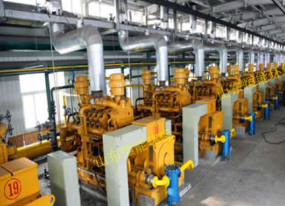沼氣脫硫脫水系統(tǒng)常見工藝
Common process of biogas desulfurization and dehydration system
隨著節(jié)能減排政策不斷深入人心��,很多企業(yè)都打算利用污水站的沼氣部分代替天然氣�,進入鍋爐燃燒或發(fā)電。那么�,沼氣利用前的硫化氫脫除工藝(脫硫)�����,就成為工廠和站長們的選擇難點����。當前,比較常用的工藝有干法脫硫�����、濕法脫硫和生物脫硫����,本文就將三種工藝為您做一個簡單的說明和對比。
With the policy of energy conservation and emission reduction becoming more and more popular, many enterprises intend to use the biogas part of the sewage station to replace the natural gas and enter the boiler for combustion or power generation. Then, the hydrogen sulfide removal process (desulfurization) before biogas utilization becomes the selection difficulty of the plant and station owners. At present, the more commonly used processes are dry desulfurization, wet desulfurization and biological desulfurization. This paper will make a simple description and comparison of the three processes for you.
一��、常見的脫硫工藝
1��、 Common desulfurization process
1. 干法脫硫
1. Dry desulfurization
干法�����、濕法和生物脫硫三大工藝比較
Comparison of dry, wet and bio desulfurization processes
沼氣從脫硫塔的一端,經(jīng)過填料層(主要成分是活性炭和氧化鐵)凈化后�,從另一端流出。硫化氫與填料層的氧化鐵發(fā)生反應�,生成硫化鐵;待氧化鐵反應結束后���,可進行再生���。
Biogas flows from one end of the desulfurization tower to the other end after being purified by a packing layer (mainly composed of activated carbon and iron oxide). Hydrogen sulfide reacts with iron oxide in the filler layer to form iron sulfide, which can be regenerated after the reaction.
脫硫原理:
Desulfurization principle:
Fe2O3 ˙ H2O+ 3H2S = Fe2S3 + 4 H2O
Fe2O3 ˙ H2O+ 3H2S = Fe2S3 + 4 H2O
再生原理:
Regeneration principle:
Fe2S3 + 3/2 O2+ 3 H2O = Fe2O3 ˙H2O + 2 H2O+ 3 S
Fe2S3 + 3/2 O2+ 3 H2O = Fe2O3 ˙H2O + 2 H2O+ 3 S
2. 濕法脫硫
2. Wet desulfurization
濕法脫硫是將沼氣送入洗滌塔�,經(jīng)堿性溶液洗滌吸收后流出��,洗滌液進入富液槽��、再生槽�����,通過使用化學藥劑方法催化��、氧化��,zui終將硫化物轉(zhuǎn)化為單質(zhì)硫(硫泡沫)����,吸收液可以再生循環(huán)使用。
Wet FGD is to send biogas into the washing tower, wash it through alkaline solution, wash it out, wash the liquid into the rich liquid tank and regeneration tank, and catalyze and oxidize it through chemical methods. Zui will eventually convert sulphide into elemental sulfur (sulfur foam), and the absorption liquid can be recycled and recycled.

3. 生物脫硫
3. Biological desulfurization
生物脫硫也是濕法脫硫的一種,與上述濕法脫硫的催化氧化工藝相比�,zui大區(qū)別是使用硫桿菌替代化學催化劑,將硫化物直接氧化成硫單質(zhì)���。
Biological desulfurization is also a kind of wet desulfurization. Compared with the above-mentioned catalytic oxidation process of wet desulfurization, Zui is different in that Thiobacillus is used instead of chemical catalyst to oxidize sulfide directly to sulfur substance.
反應原理:
Reaction principle:
H2S + OH-= HS- + H2O
H2S + OH-= HS- + H2O
HS- + 1/2O2= So + OH-
HS- + 1/2O2= So + OH-
說明:
explain:
1) 干法脫硫多用于硫化氫處理負荷小,或者對脫硫效果要求很高的工況��。這時���,干法脫硫多用于濕法脫硫或者生物脫硫之后����,進一步脫硫�����。
1) Dry desulfurization is often used in the condition of small load or high demand for desulfurization effect. At this time, dry desulfurization is mostly used for further desulfurization after wet desulfurization or biological desulfurization.
2)在制定脫硫效果時�����,建議根據(jù)后續(xù)設備(鍋爐或發(fā)電機)對硫化氫濃度的限制�,以及沼氣與天然氣消耗量的比例,制定一個合理的脫除效果�。我們通常建議zui終的硫化氫含量控制在25~100ppm。
2) When formulating the desulfurization effect, it is suggested to formulate a reasonable desulfurization effect according to the restriction of subsequent equipment (boiler or generator) on the concentration of hydrogen sulfide and the proportion of biogas and natural gas consumption. We usually suggest that the content of hydrogen sulfide in Zui should be controlled at 25-100ppm.
沼氣脫水的方法
Method of methane dehydration
從發(fā)酵裝置出來的沼氣含有飽和水蒸氣,可用3種方法將其去除���。
The biogas from the fermentation plant contains saturated water vapor, which can be removed by three methods.
(1)冷分離法�。
(1) Cold separation method.
冷分離法是利用壓力能變化引起溫度變化���,使水蒸氣從氣相中冷凝下來的方法���。常用的有兩種流程:A.節(jié)流膨脹冷脫水法。一般用于高壓燃氣�,經(jīng)過節(jié)流膨脹或低溫分離,使部分水冷凝下來�����。B.加壓后冷卻法���。如凈化氣在0.8MPa壓力下的冷卻脫水.
The cold separation method is a method which uses the pressure energy change to cause the temperature change and make the water vapor condense from the gas phase. There are two commonly used processes: A. throttling expansion cold dehydration. Generally used for high-pressure gas, after throttling expansion or low-temperature separation, part of the water is condensed. B. Cooling after pressurization. For example, the purified gas is cooled and dehydrated under the pressure of 0.8MPa
(2)溶劑吸收法�。屬于這類脫水溶劑的有氯化鈣����、氯化鋰及甘醇類。
(2) Solvent absorption method. The dehydrating solvents are calcium chloride, lithium chloride and glycol.
(3)固體物理吸水法����。吸附是在固體表面力作用下產(chǎn)生的�,根據(jù)表面力的性質(zhì)分為化學吸附脫水后不能再生)和物理吸附(脫水后可再生)
(3) Solid physical water absorption method. Adsorption is generated under the action of solid surface force. According to the nature of surface force, it can be divided into chemical adsorption, dehydration, non regeneration and physical adsorption (regeneration after dehydration)
沼氣脫硫脫水系統(tǒng)是沼氣生產(chǎn)中必不可少的設備�����,脫硫脫水設備凈化沼氣中的有害氣體��,保證在這一過程中沼氣有效安全的產(chǎn)出����。
The desulfurization and dehydration system of biogas is an essential equipment in biogas production. The desulfurization and dehydration equipment can purify the harmful gas in biogas and ensure the effective and safe output of biogas in this process.
